Submitting Rabies Specimens to DSHS Laboratory
Specimen Submission Steps
The steps to submitting rabies specimens are outlined in the graphic. Each specimen submission step is discussed in more detail below. These instructions were developed to comply with 49 CFR §171–173, which are the Federal regulations relating to the shipping of hazardous materials including specimens for rabies testing.
A tutorial on packing and submitting rabies specimens is available for download. Click here to go to the specimen submission tutorial: Submitting Rabies Specimens to the DSHS Laboratory.

1. Collect and Label Specimen
Submit only the animal’s head unless it is a bat or a small rodent. Bats must be submitted intact to allow for species identification.
Live animals will not be accepted!
Animal identifiers provided in the rabies notification form and the accompanying G-9 specimen submission form must be identical to allow proper specimen tracking.
Required Rabies Specimens
Specimens must be packaged in sturdy, leakproof containers.
NOTE: DSHS Laboratory does not provide shipping containers for rabies specimens. Specimen shipping containers can be returned to submitters only when the submitter provides sufficient return postage (in the form of stamps or a shipping label). Cash or checks are not acceptable.
- Do Not Submit LIVE Specimens! We cannot accept live animals.
- Do Not Fix Brain Tissue In Formalin or Any Other Fixative! They can interfere with the testing process.
- Avoid Damaging the Brain. Traumatic injury to the head and brain may compromise the test and results.
- Minimum Brain Specimen Requirements for Testing Fresh brain tissue is acceptable. If only the brain is submitted a complete transverse cross section of the brain stem and tissue from the cerebellum and/or hippocampus is required.
- Submit Only the Head of Animals Larger Than a Bat or Small Rodent. Have a qualified person separate the animal head from the body as soon as possible after death.
- Immediately Chill the Specimen to (2ºC – 8ºC). Submit specimens as soon as possible after collection.
- Do Not Freeze Specimens! Freezing will delay test results and may damage the brain tissue.
- Specimens Cannot be Returned to Submitters. Due to biohazard safety guidelines the laboratory is unable to return heads or carcasses to submitters, no exceptions.
Specimen Labeling Requirements
- Every specimen submission must have at least one unique identifier affixed to it (preferably on the sealable bag holding the specimen).
- Every specimen must have an accompanying G-9 submission form.
- Identifiers on the specimen, on the rabies notification form, and the G- 9 submission form must match exactly.
Acceptable specimen identifiers include but are not limited to
- A Unique Identification Number
- Patient File Number
- Animal Name
2. Obtain a G-9 Specimen Submission Form
A G-9 Rabies Specimen Submission Form is required for every rabies specimen.
Submitters may contact Laboratory Reporting to request a G-9 submission form by emailing LabInfo@dshs.texas.gov, calling (512) 776-7578 or 1-888-963-7111 ext. 7578 (toll free), or faxing (512) 776-7533.
Laboratory Reporting staff will pre-populate Section 1 of the form with submitter information. An electronic version of the pre-populated form will be emailed, or a hardcopy will be faxed or mailed to the submitter upon request. Submitters may also download the form, which is available here.
PLEASE NOTE:
- Hard copies of completed forms must be provided and shipped with specimens.
- DSHS cannot accept electronic versions of the G-9 submission form.
- If submitting several specimens at once, a separate G-9 form is required for every specimen in the shipment.
- Submitters are not required to have a DSHS submitter ID number to obtain a G-9 submission form or submit a rabies specimen.
Required Fields on G-9 Specimen Submission Forms
Providing a completed specimen submission form with each specimen is critical to successful testing. The unique identifiers on the specimen submission notification form must exactly match the identifiers provided on the G-9 submission form. Missing information and/or mismatches between specimen identifiers may result in delayed testing.
To minimize transcription mistakes, please complete submission forms neatly and legibly in pen.
The following information is required on every G-9 submission form:
- Submitter’s Name
- Submitter’s Street Address, City, State, and Zip Code
- Submitter’s Contact Phone Number
- Submitter’s Contact Fax Number (when available)
- Animal Type/Species
- Unique Animal Identification Code (created by submitter and should match the ID on the specimen container)
- County of Animal’s Origin
- Human and/or Pet Exposure Details
Sample G-9 Submission Form Showing Required Fields for Rabies Submissions (in Green)
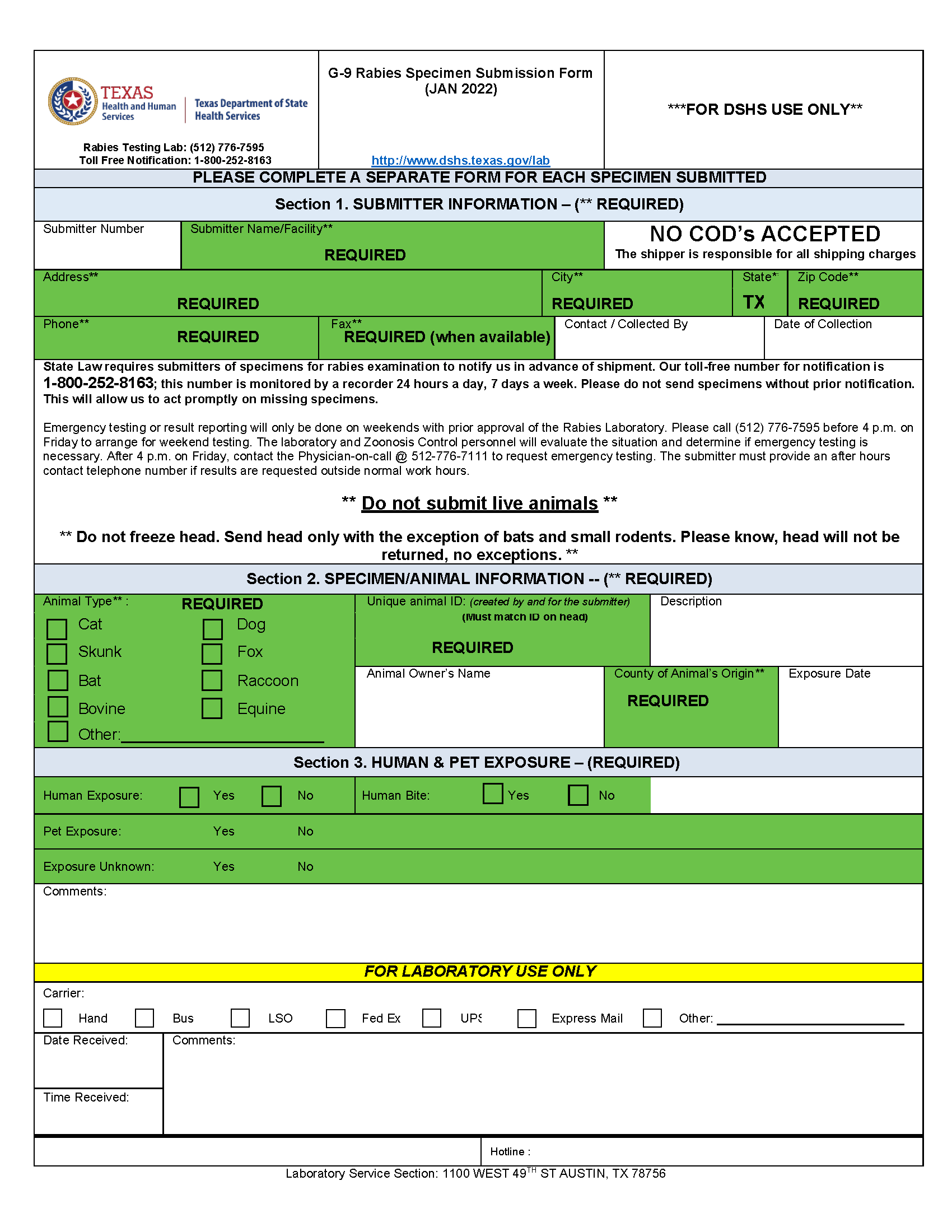
|
Submitter’s Name/Facility SECTION 1 |
Provide the name of the person or facility submitting the specimen. Laboratory Reporting staff will add this information when a submitter requests a form. |
|---|---|
|
Submitter’s Name and Address SECTION 1 |
Provide the submitter’s or submitting facility’s name, address, City, State, and Zip Code. Laboratory Reporting staff will add this information when a submitter requests a form. |
|
Submitter’s Phone and Fax Numbers SECTION 1 |
Provide the name, telephone number, and fax number of the point of contact (POC) or the submitter or submitting facility in case the laboratory needs additional information about the specimen. Laboratory Reporting staff will add this information when a submitter requests a form. |
|
Animal Type SECTION 2 |
Check the appropriate box. If the animal type is not listed on the form, check “Other” and write in the animal type next to it. Provide animal owner’s name, if known. |
|
Human and Pet Exposure SECTION 3 |
Indicate the exposure of humans and/or pets to the animal. Identify whether a person was bitten by the animal. If the exposure is unknown, check “Yes” next to Exposure Unknown on the form. Add clarifying comments as needed. |
- *The unique animal identifier on the specimen and notification form MUST exactly match the identifier provided in the submission form to allow proper tracking of the specimen by the Lab.
- All required information on a submission form is marked with double asterisks (**).
- Do not bundle two or more specimens on a single submission form.
Questions about submission forms can be directed to the Laboratory Reporting Group at (512) 776-7578, 1-888-963-7111 ext. 7578 (toll free), or email: LabInfo@dshs.texas.gov.
3. Notify DSHS Laboratory of Specimen Submission
REGARDLESS OF THE MODE OF DELIVERY, EVERY SUBMITTER MUST FIRST NOTIFY LABORATORY STAFF OF A RABIES SUBMISSION!
- Complete and submit the online Rabies Submission Electronic Notification Form ("Coming Soon"), or
- Call the Rabies Hotline at 1-800-252-8163
To alert the Laboratory staff of the expected arrival time and to provide other submission information.
Specimen Notification Process
- The electronic notification form may be used for up to six specimens at a time. If submitting more than six specimens, an additional notification form is required.
- Alternatively, call the 24-hour, toll-free Rabies Hotline at 1-800-252-8163 to alert the laboratory staff of the expected arrival time and to provide other submission information.
- If calling the Hotline, provide the following details in a message.
- Submitter’s name and contact information.
- Number of specimens being submitted.
- Type of animal(s) being submitted.
- Method of shipment (by courier or hand delivered).
- Expected arrival time of the specimen(s).
- A Submitter ID Number is not required to submit rabies specimens.
4. Shipping/Delivering Rabies Specimens to DSHS
Rabies specimens may be shipped via courier or other delivery service, or be hand delivered by submitters to the Lab’s Specimen Receiving Dock during regular business hours, Monday–Friday, 8:00 a.m.–5:00 p.m.
The Specimen Receiving Dock is on the north side of the Laboratory building and is accessible from Grover Street, as shown in the DSHS Central Complex campus map.
A tutorial on packing and submitting rabies specimens is available for download. Click here to go to the specimen submission tutorial: Submitting Rabies Specimens to the DSHS Laboratory. Specimens submitted to the Laboratory for rabies testing are classified as infectious substances. To minimize the risk of exposing mail handlers and carriers to infectious substances, specimens must be shipped according to Category B Biological Substance, UN3373 requirements. Per 49 CFR §173.199: Handling and Transporting Infectious Substances, specimens must be labeled as Biological Substance, Category B UN3373.
- Category B UN3373 specimens must be triple packaged in leakproof, sturdy containers to withstand shocks, pressure changes, leaks, and other conditions related to ordinary handling in transit.
- If you ship via overnight air courier, such as FedEx, you must comply with the more stringent International Air Transportation Agency (IATA) regulations for Biological Substances.
- Contact your courier for appropriate packaging and labeling instructions if your specimen is to be shipped by air.
- Please do not ship a specimen to arrive on a weekend or holiday. Do not ship via overnight carrier on Friday or the day before a holiday!
- A Rabies Submission Form (G-9) must be completed for each rabies specimen submitted.
Packaging and Shipping Rabies Specimens as Biological Substances, Category B UN3373
A downloadable tutorial with these instructions is available here.
Category B Biological Substance UN3373 Shipping Definitions:
- Primary Container: A sealable, leakproof plastic bag such as a zip-top storage or freezer bag.
- Secondary Container: A sealable, clear, plastic storage or freezer bag (could also use a biohazard transport bag).
- Sturdy Outer Mailer: An insulated cardboard or polystyrene shipping box with a sealable, secure-fitting lid. Plastic bags, paper envelopes, and containers without lids are not suitable outer mailers.
- Absorbent Material: A material such as cellulose wadding, newspaper, butcher paper, or paper towels that can soak up an entire spill of contents in the primary container(s), should they leak.
Acceptable Specimens
- Only the head of animals are acceptable, unless the animal is a very small mammal such as a bat or mouse.
- Entire/intact bats are needed to identify the species.
- If only the brain is to be submitted, minimum tissue requirements for testing are a complete transverse cross section of the brain stem and tissue from the cerebellum and/or hippocampus.
- Avoid physical damage to the brain, as it may compromise the test.
- DO NOT FIX BRAIN TISSUE IN FORMALIN OR ANY OTHER FIXATIVE!
- DO NOT SUBMIT ENTIRE ANIMAL CARCASSES unless a bat or other small mammal such as a mouse.
- Immediately chill the specimen(s) to between 2ºC and 8ºC, being careful not to freeze.
Place Specimen in Primary Container
- Each specimen must be placed in a leakproof, sealable plastic bag.
- Use a waterproof or permanent ink pen to label the primary container bag with a unique identification code, such as the one shown in the photo below.

Example of a specimen identification label written on a sealable primary container (bag).
Place All Primary Container(s) in Secondary Container
- Primary container must then be put inside a second, sealable, plastic bag.
- Several primary containers (bags) may be placed in a larger secondary container bag.
- Make sure all primary and secondary container bags are securely sealed to prevent leaks.
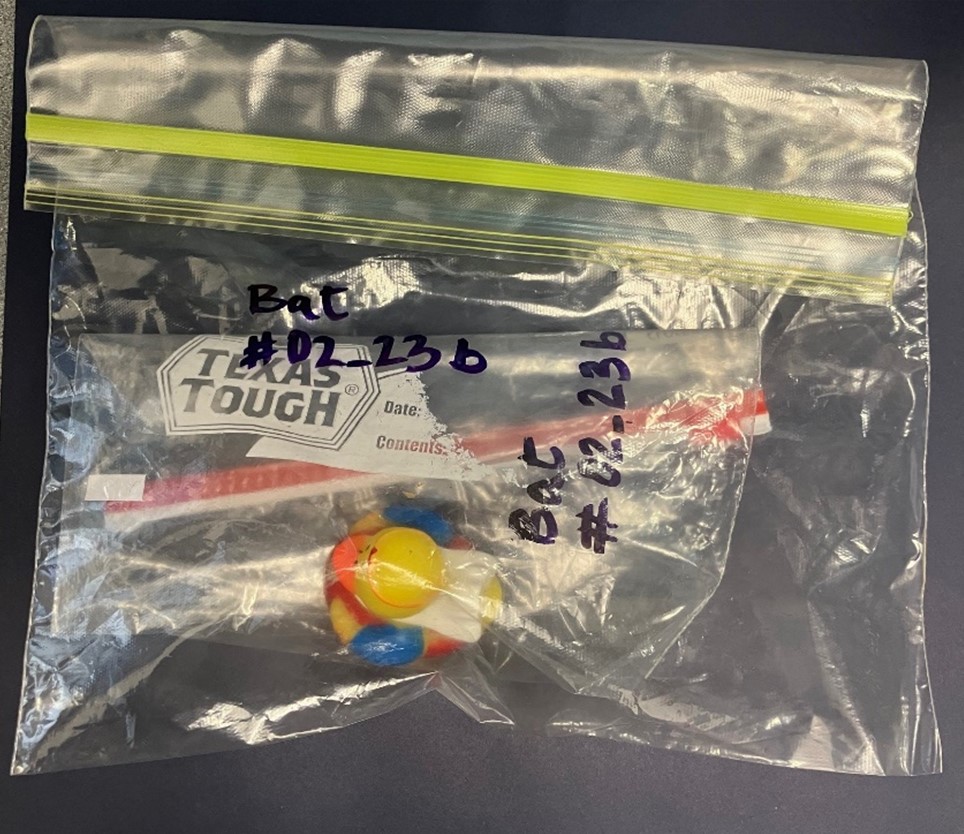 Primary containers must be placed inside a sealable secondary container such as a larger bag. The identification code(s) of the enclosed specimen(s) must be written on the secondary container too.
Primary containers must be placed inside a sealable secondary container such as a larger bag. The identification code(s) of the enclosed specimen(s) must be written on the secondary container too.
List Specimen ID(s) Clearly on Secondary Container
- Write or attach an identification code to the outside of each double-bagged specimen.
- Specimen identification codes(s) should exactly match the information provided in the electronic notification form and the G-9 specimen submission form.
- Matching identification codes are especially important if more than one specimen is sent in the same package.
Prepare Outer Shipping Container
- Line the bottom and sides of a sturdy insulated container with absorbent packing material. Use enough to cushion the specimen(s) and to absorb any leaks.
- Polystyrene peanuts are not recommended as they are not absorbent.
- Place the double-bagged specimen(s) inside a sturdy insulated container, such as a polystyrene box nested inside a cardboard box.
- Place enough cold gel packs, or similar refrigerants around the specimen bag(s) to ensure specimens are completely covered and will remain cold for at least 48 hours.
- DO NOT USE DRY ICE!
- Keep current weather conditions (particularly our hot Texas summers) in mind when packing the specimen(s) and include enough cold packs to keep the specimens cold for at least 48 hours.
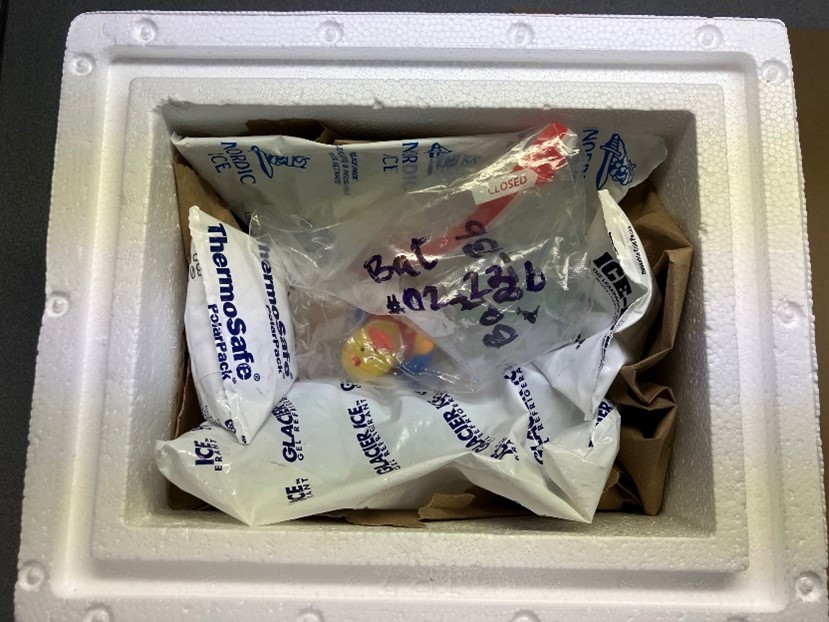 Pack the specimen with enough cool packs to keep it cool while in transit. Minimize empty space around the specimen to improve insulation.
Pack the specimen with enough cool packs to keep it cool while in transit. Minimize empty space around the specimen to improve insulation.
- Fill any remaining space around the specimens and gel packs with absorbent material to improve cushioning and insulation.
- Close the lid of the inner container and place it inside the rigid outer container (cardboard box).
Include Completed G-9 Specimen Submission Form
- Place the completed G-9 Rabies Submission Form(s) in a sealable plastic bag and seal the bag to ensure it is protected from leaks. Multiple forms may be placed in the same bag.
 Placing the submission form in a sealable plastic bag protects it from leaks.
Placing the submission form in a sealable plastic bag protects it from leaks.
- Place the sealed submission form in the insulated container with the specimen, or affix to the lid of the inner container/box.
- Close the lid of the outer container, securing with packing tape.
Label Outer Mailer Correctly
- Affix a diamond shaped UN3373 label on the exterior of the outer container next to or near the "Biological Substance, Category B" label.
- The UN3373 label must be a minimum of 3.9 in x 3.9 in (10 cm x 10 cm). And the sides of the UN3373 diamond must be at least 2 in (5.1 cm) wide. If preprinted labels are unavailable, you may size up and print the UN3373 label shown below. If you don’t have access to a printer, you may also draw the diamond on the outer box with a black pen or marker and write UN3373 inside it.
 You may size up this image to print it out and attach to the outer container.
You may size up this image to print it out and attach to the outer container.
- Attach a return address label to the top of the sealed outer container. (The return address label must include the name, address, and telephone number of the submitter and/or a person knowledgeable about the shipment of the rabies specimen.)
- The package is then ready to ship.
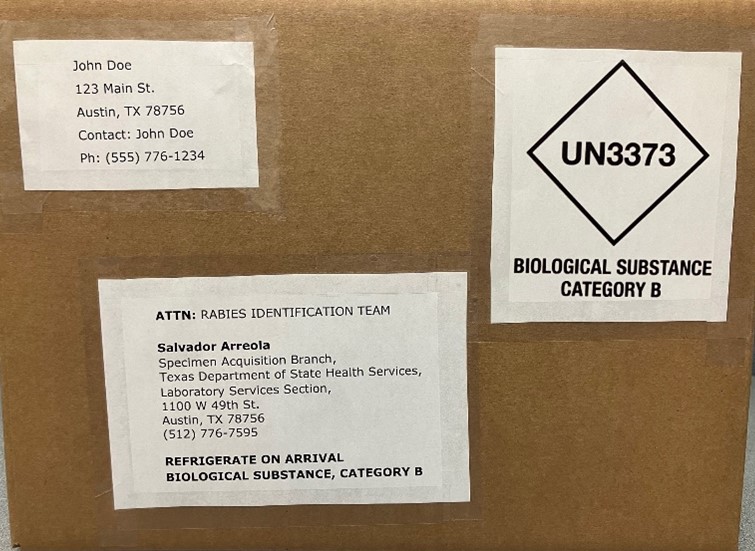 Example of the correct placement of required labels on rabies specimen container.
Example of the correct placement of required labels on rabies specimen container.
Laboratory Shipping Address for Rabies Specimens
ATTN: Rabies Identification Team
Salvador Arreola,
Specimen Acquisition Branch,
Texas Department of State Health Services
Laboratory Services Section
1100 W. 49th Street
Austin, TX 78756
512-776-7595
Be sure to label the outside of the shipping package with “BIOLOGICAL SUBSTANCE, CATEGORY B”, a UN3373 shipping label, and “REFRIGERATE ON ARRIVAL”
A Note on Returning Shipping Containers to Submitters
Specimen shipping containers can be returned only when the submitter provides sufficient return postage (in the form of stamps or a shipping label). Cash or checks are not acceptable.
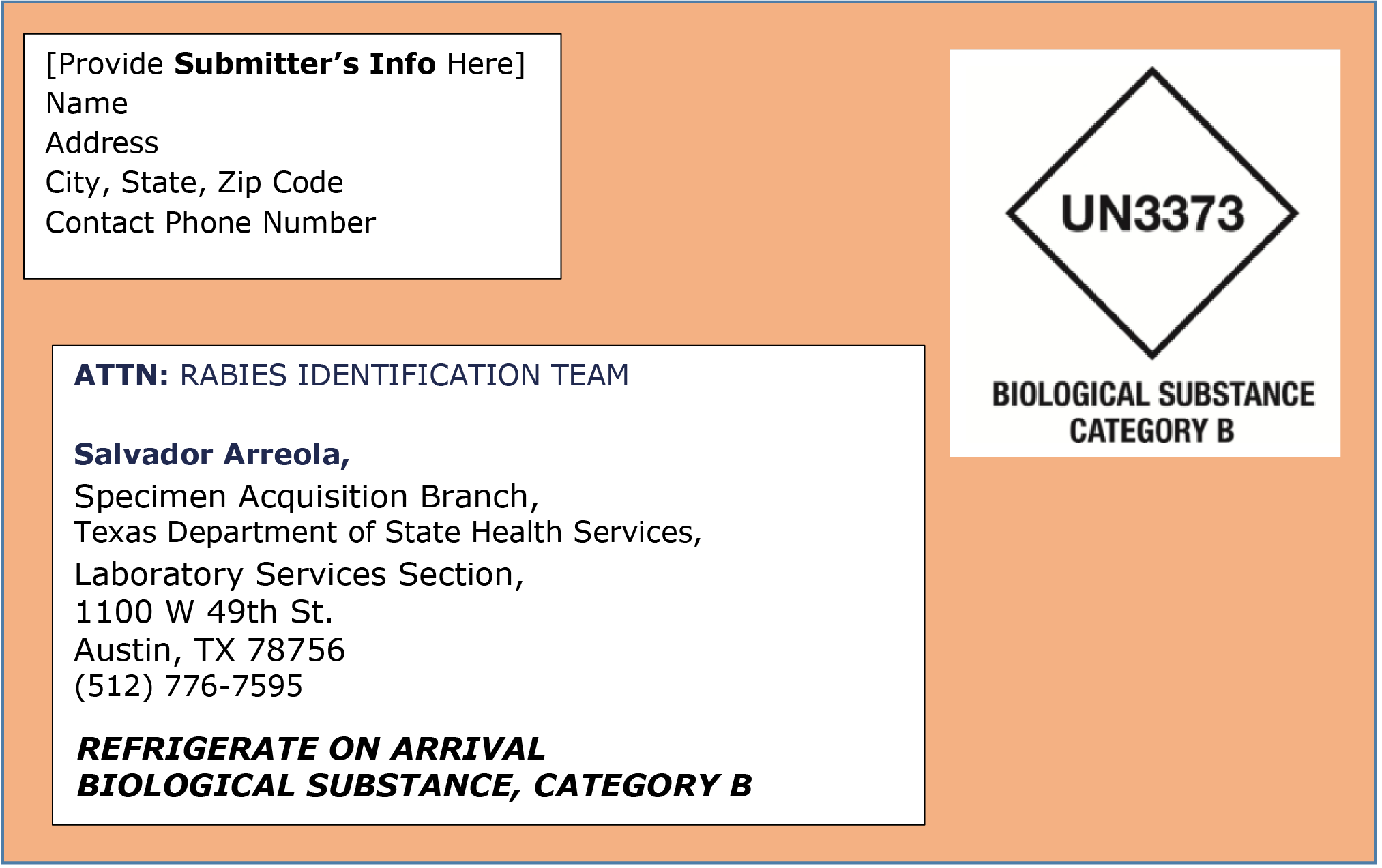
Rabies Submission Checklist
Before shipping your specimens, make sure you have
- alerted the Laboratory of your submission via the online form or by calling the Rabies Hotline at 1-800-252-8163,
- packed only the head of the animal, unless it is very small (such as a rodent or bat),
- labeled the specimen with a unique identifier,
- completed a G-9 specimen submission form for each specimen,
- ensured the specimen information and identifier(s) on the notification form, on the specimen, and on the G-9 submission form match,
- packed the specimen according to Infectious Substance, Category B UN3373 shipping requirements,
- packed cold packs, not dry ice with specimen, and
- affixed all required shipping labels and notices to the outer mailer.
